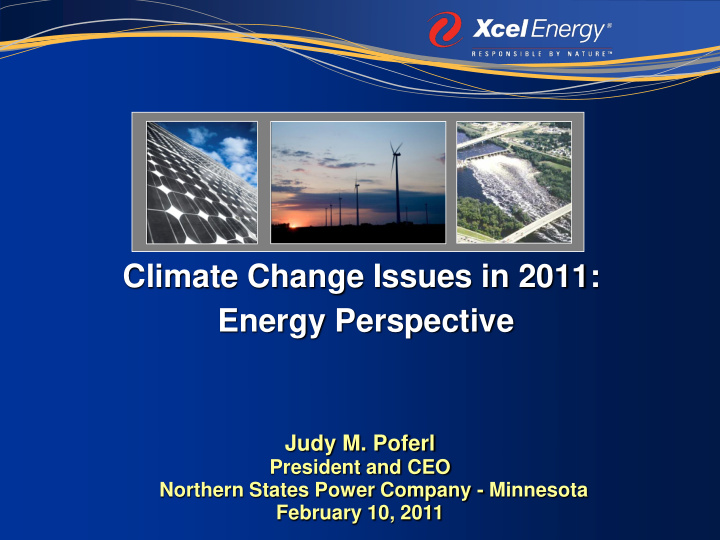



Climate Change Issues in 2011: Energy Perspective Judy M. Poferl President and CEO Northern States Power Company - Minnesota February 10, 2011
Xcel Energy Service Territories Maintain reasonably Northern States Northern States Power Company priced, reliable energy Power Company Minnesota Wisconsin Address risk through advanced, balanced, and Public Service Company of diverse energy portfolio Colorado Create value for customers, shareholders and employees Southwestern Public Service Gas Customers 1.9 M Company Electric Customers 3.4 M
Xcel Energy‟s Perspective Clarity and certainty of rules is essential — Aging infrastructure — Long-lead time, long-lived assets — Significant capital required Investments should prove valuable from a variety of perspectives — Cost — Reliability — Environment — Risk
CO 2 Emissions: 2003 to 2020 Millions of tons 36 32 26% Reduction 28 2003-2020 24 20 2003 2005 2007 2009 2011 2013 2015 2017 2019
Emission Reduction Initiatives Minnesota Emissions Reduction Project Retrofit Preserve Retrofit one unit to BACT level controls “anchor” valuable Retire five units coal units assets for the Construct two natural gas combined future cycle units Maintain Retire Black Dog Proposal “heritage” Retire 270 MW of remaining coal reasonable Construct natural gas combined cycle unit coal units long-term cost Approach requires significant investment and supportive regulation
Nuclear Monticello Plant Prairie Island Plant Low cost, emission-free, carbon-free, reliable base load License extensions save customers money ($1 billion) Expanded capacity to meet growing needs (+235 MW)
Concurrent Strategies Nation‟s No. 1 Wind Provider Savings Nation‟s No. 4 Energy Demand Efficiency Programs 2.1 million kW Transmission investments Commitment to innovation Natural Gas 9.3 million MCF ▬ Energy Innovation Corridor ▬ Electric vehicles Electricity 4.8 billion kWh MW NSP Wind Capacity 4000 3000 Results: Equivalent of 2000 removing 4 million metric tons of CO 2 emissions 1000 0 2006 2009 2015 2020
Upper Midwest Fuel Mix 2009 2025 Nuclear Nuclear Other Other 27% 28% 6% 12% Natural Gas Wind Wind Natural 6% 8% 20% Gas 16% Coal 47% Coal 30%
Capital Forecast Dollars in millions $2,675 $2,290 $2,235 $2,125 2010 2011 2012 2013 Other Nuclear Fuel Nuclear Uprate & Life Ext Natural Gas Electric Distribution Electric Transmission Electric Generation Wind
EPA Initiatives Non-CO 2 Environmental Regulatory Timeline for Coal Units Ozone SO 2 /NO 2 CAIR Water Beginning CAIR SO 2 Final CAIR Phase I Seasonal Effluent Guidelines Regional Haze BART Primary Replacement NOx Cap Final Rule Expected Compliance NAAQS Rule Expected Revised SO 2 /NO 2 Next Ozone Ozone Reconsidered Secondary Proposed Effluent Guidelines NAAQS Revision Ozone NAAQS NAAQS CAIR Compliance 3-5 Yrs NAAQS Replacement After Final Rule 316(b) Effluent CAIR Rule Compliance Guidelines Vacated 316(b) Final Expected 3-4 Yrs After Proposed NO 2 Rule Final Rule Rule CAIR Primary Expected Expected Remanded NAAQS ‟12 ‟14 ‟15 ‟16 ‟17 ‟10 ‟13 ‟08 ‟09 ‟11 PM-2.5 Final Begin CAIR PM-2.5 Next SIPs Due Rule for Phase I SIPs Due („06) PM-2.5 Beginning CAIR („97) CCBs Annual SO 2 Beginning NAAQS Phase II Annual SO 2 New PM-2.5 NAAQS Mgmt Cap CAIR Revision & NOx Caps Designations Phase II CAMR & HAPS Begin Seasonal MACT Delisting Begin Compliance CAIR HAPS MACT Proposed Rule NOx Cap Rule Final Rule Compliance Requirements Proposed Phase I for CCBs Expected Vacated with CAIR Under Final CCB Annual Rule Management Replacement HAPS MACT Rule (Ground Regional NOx Final EPA Rule Compliance Haze Water Monitoring, Cap Regional 316(b) Proposed Non-attainment 3 Yrs After Compliance Double Monitors, Haze BART Rule Expected Designations Final Rule Deadline Closure, Dry Ash Submitted to Regional Haze SIP Conversion) *Adapted from Wegman EPA PM 2.5 Ash Hg/HAPS Submitted to EPA (EPA 2003) Updated 2.15.10
Key Decisions Retire and Replace Natural gas supplemented with renewables? Higher operating costs? More volatility? Retrofit More retrofits in the future? Future carbon costs? Costs over useful life?
Looking Forward Continue to pursue balanced, diverse energy portfolio — Coal, nuclear, gas, renewables and efficiency Address coal infrastructure — Retire and replace aging coal infrastructure — Retrofit the more efficient “anchor coal” — Invest in natural gas and renewables as appropriate Explore and implement cost-effective new technology development Advocate for flexible, low-cost energy and environmental policies
Recommend
More recommend